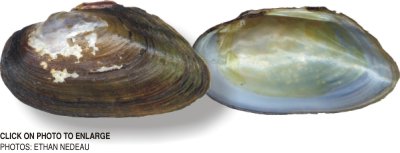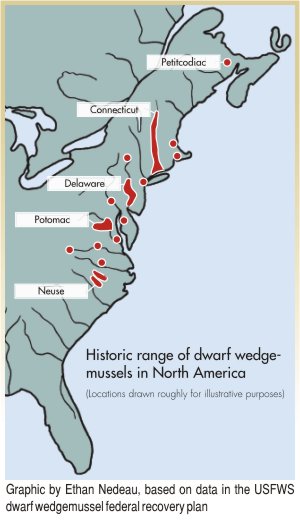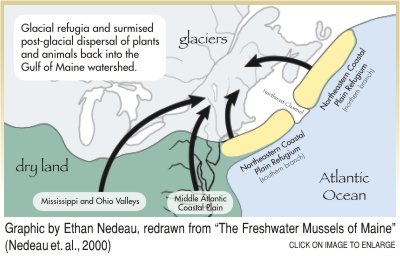
In hopes the dwarf wedgemussel survives
Presumed extirpated, surveyors have discovered new populations
By Ethan Nedeau
Printer Friendly Page
But more on that in a bit.
Not long ago, I drove north along the eastern flank of the Green Mountains before dawn, listening
to highway music and dreaming of discovery. Morning light filled the valley by five o'clock; from atop
a glacial escarpment my eyes followed a ribbon of mist hovering over the Connecticut River. I drove
into and out of river fog for a while as the highway descended into valleys and climbed mountains.
Then the highway took me away from the river for a jaunt through spruce-fir forests before finally
wending its way back to the river's silver maple floodplain in northern New Hampshire. The reflection
of the Dartmouth Range of the White Mountain National Forest was my last glimpse of the landscape for
a while. I donned SCUBA gear, descended ten feet below the surface, and worked slowly upriver in
search of the small and cryptic dwarf wedgemussel.
The dwarf wedgemussel (Alasmidonta
heterodon) is a freshwater bivalve that spends most of its life partially
buried in the bottom of rivers, with just the posterior end of the body
visible. Individuals are usually not more than 1.5 inches long and are
olive-brown or black. Dwarf wedgemussels could potentially live among
eight to nine larger and more common species in any single location throughout
their range, some of which outnumber them by more than 1,000 to 1 (such
as the eastern elliptio, Elliptio complanata). Because it is a
species of great conservation concern, surveys are routinely done to discover
new populations, monitor known populations and mitigate effects of projects
such as bridge and dam maintenance or bank stabilization. Such construction
and maintenance projects often cause mortality of mussels by dewatering
areas of the riverbed, changing physical habitat or by increasing sedimentation.
Finding dwarf wedgemussels requires a quirky mix of stamina, patience, devotion and masochism.
Searchers must look very carefully in the right place. The “right place” is an elusive concept that
has not yet been fully described; it is the Holy Grail for researchers who study the species. The
key seems to be stability, a somewhat murky concept that is difficult to measure and might have
different meanings in different rivers. Distinguishing areas that remain stable in extreme
conditions - such as droughts and floods - is critical to discovering mussels because they are
sedentary long-lived animals that are sensitive to environmental changes. It takes time to learn
to read a river and recognize telltale clues such as patterns of meanders, the slope of the land,
configurations of riffles and pools and ribbons of different substrates. For me, it's a feeling
more than a quantifiable set of variables.
Once you discover the right place, finding dwarf wedgemussels is mostly about pattern
recognition - training the eyes to discern between sticks, stones and other species of mussels
and learning to read a river on a small scale. It also requires enduring cold water, smothering
darkness, strong currents and creepy-crawly feelings of spending hours underwater. Even then,
you might spend hours or even days searching in vain before abandoning hope and concluding that
it simply does not, or has ceased to, inhabit a river. Patience and persistence sometimes yield
great rewards. An assistant and I once spent nearly 25 man-hours surveying a short distance upstream
of a dam and found only two dwarf wedgemussels - the first after 12 hours of effort.
Among the rivers where dwarf wedgemussels were presumed extirpated was New Brunswick's
Petitcodiac. Extensive surveys conducted in 1984, 1997 and 1998 could not find the species, and
the Canadian government formally declared that the species was extirpated from the Petitcodiac in
1999 after a 40-year absence, thereby also declaring it extinct nationally because the Petitcodiac
was the only Canadian watershed that supported the species. The declaration also meant that dwarf
wedgemussels were officially extirpated from the entire Gulf of Maine watershed because the species
only occurred in the Petitcodiac (except for a dubious historic record from the Merrimack River at
an unspecified location and date).
The dwarf wedgemussels of the Petitcodiac River represented a disjunct population - they were
separated from the species' core range to the west. Although dwarf wedgemussels were historically
documented in the Canoe and Agawam Rivers in southeastern Massachusetts and in the Merrimack River
near Andover, Massachusetts, the Petitcodiac harbored the only population farther to the east.
Watersheds in between - the Saco, Androscoggin, Kennebec, Saint George, Penobscot, Saint John and
countless smaller watersheds - which support some of the most viable populations of freshwater
mussels along the entire eastern seaboard, did not support dwarf wedgemussels. This assertion is
supported by many years of surveys in Maine, where surveyors (including me) have searched over 1,700
locations since the early 1990s. The Petitcodiac population was the zoogeographic puzzle piece that
had mystified researchers for decades. How did dwarf wedgemussels ever get that far east?
Dispersal is one of the more interesting traits of freshwater mussels. Though adults barely move
more than a few meters during their lives, the parasitic larvae (called glochidia) are released into
the water and attach to the fins or gills of a fish. Some species of mussels are very specific about
which fish their larvae will attach to, often using only a small fraction of the entire pool of fish
species in a waterbody. Dwarf wedgemussels are more specific than many species, and currently the
only species that are known hosts are the tessellated darter (Etheostoma olmstedi), Johnny darter
(Etheostoma nigrum), slimy sculpin (Cottus cognatus), mottled sculpin (Cottus bairdi) and juvenile
Atlantic salmon (Salmo salar). Tessellated darter is considered the primary host.
Freshwater mussels are only capable of long distance dispersal during the parasitic phase of
their lives, provided the fish are capable of, and actually swim, long distances. Of the dwarf
wedgemussel's known hosts, Atlantic salmon is the only species that can migrate long distances.
Though glochidia might remain on a fish for several weeks, they likely cannot survive in the ocean
(at least not long-distance transport), and there is no way that fish could have carried glochidia
from southern New England into eastern New Brunswick to begin a new population. So although dispersal
of mussels within a watershed is easily explained, dispersal into neighboring coastal watersheds is
not.
The Northeast Channel, a deep trench in between the Grand Bank and Georges Bank, divided the
glacial refuge that existed over the northeastern coastal plain into two pieces. Plants and animals
that had occurred throughout the Gulf of Maine watershed were separated for thousands of years until
the glaciers receded. As glaciers retreated, terrestrial and freshwater species dispersed back into
New England and eastern Canada along two routes - one across modern-day Nova Scotia into eastern New
Brunswick and eastern Maine, and the other into southern New England. Species with strong dispersal
abilities could have bridged the gap and filled Maine, whereas species with poor dispersal abilities
may have never bridged the gap. The disjunct population of dwarf wedgemussels in the Petitcodiac
might represent the only descendents of the populations that endured glaciation in the northern
piece of the northeastern coastal plain refuge. A few mussel species exhibit a similar range pattern
and strengthen this theory, including yellow lampmussels (Lampsilis cariosa), tidewater muckets
(Ligumia ochracea), brook floaters (Alasmidonta varicosa) and eastern lampmussels (Lampsilis radiata).
If the theories are true, the Petitcodiac population of dwarf wedgemussels had been genetically
isolated for more than 50,000 years, perhaps long enough for speciation to begin. Molecular and
genetic analysis might still reveal the degree of divergence from species in New England and the
mid-Atlantic states (because museum specimens are available). Ecological studies could have
revealed differences in life history traits and host fish. For one thing, tessellated darters
do not occur in New Brunswick or Maine. Of the dwarf wedgemussel's known hosts, only the Atlantic
salmon and slimy sculpin occur in eastern Maine and New Brunswick, and only Atlantic salmon are
known in the Petitcodiac. But other species could have also been hosts. These questions may never
be answered because the Canadian population is lost - they withstood the advance and retreat of
glaciers and persisted for millennia of environmental change, but vanished within decades of intense
human pressure.
Freshwater mussels are one of the most endangered groups of species on Earth. North America has
297 native species, and of those, 35 went extinct in the last century and nearly three-quarters are
considered imperiled throughout all or parts of their range. Seven of the 12 species in the Gulf of
Maine watershed are listed as endangered, threatened or species of special concern in at least one
state or province. The greatest threats are damming and channelization of rivers, sedimentation,
pollution (in countless forms from myriad sources) and introduced species. Even stressors that
have mild effects on their own could have synergistic effects with other stressors and greatly
exceed the tolerance of sensitive species. North America's rivers have been assaulted in countless
ways and its fauna - particularly fish and mussels - have suffered tremen-dously.
However, I am not going to drag you through a narrative of doom and gloom. In fact, I am an
optimist when it comes to freshwater mussels because I have a hard time believing in extinction.
I got goosebumps when I heard the story on National Public Radio about the ivory-billed woodpecker
and couldn't help but think about dwarf wedgemussels. Since the federal recovery plan for dwarf
wedgemussels was published in 1993, surveyors have found nearly 40 new populations in locations
where the species had been presumed extirpated or in rivers where the species had never been found.
The largest known population in the world exists in the upper Connecticut River in an area that
was denoted “historic, presumed extirpated” in 1993. This area hosts hundreds of thousands of animals.
While studying this population, an assistant and I found 1,441 dwarf wedgemussels in a 120 square
meter area - more animals than have been counted in all other locations combined in the last decade,
except perhaps the intensively studied population on the Neversink River in New York. Discoveries
or rediscoveries of dwarf wedge-mussels in the Connecticut River and many of its tributaries during
the last decade have given managers an entirely different view of the species, and this new
information is attributed to sampling effort. However, most surveys were designed to find the
species rather than provide rigorous population estimates and demographic analyses. We still do not
know population trends or how stable the species is throughout its range.
Scientists surmise that construction of a causeway between Moncton and Riverview in 1968 led to
the extinction of the Petitcodiac dwarf wedgemussel population. The causeway greatly reduced the
migration of anadromous fish such as American shad (Alosa sapidissima) and Atlantic salmon that
may have been important hosts. This cause-effect relationship has been shown in other rivers for
other species, such as the alewife floater that parasitizes alewife and shad. But in my long drives
to northern New Hampshire, passing by 10 dams before reaching the finest dwarf wedgemussel
population in the world, I can't help but wonder if blockage of anadromous fish passage really
doomed the dwarf wedgemussel population in the Petitcodiac. The population could have been
extirpated by other causes such as water quality issues, habitat degradation or a population
that was so small that recruitment failed and it dwindled to nothing.
In my quest to understand the dwarf wedgemussel and piece together patterns of zoogeography and
extirpation, the thing that torments me the most is the point at which we conclude that a species is
gone. Very few mussel surveys have ever thoroughly searched more than one percent of a river's
bottom. Sometimes it is easier to claim extirpation and write eloquently about causes than to submit
that surveys may have been ineffective at detecting a species with an extraordinarily low population
density and patchy distribution. Canadian researchers Andrea Locke, Mark Hanson and many others
have searched tirelessly for dwarf wedgemussels in the Petitcodiac, which might now be one of the
most intensively surveyed rivers in North America. Only with great reluctance and years of
waterlogged shoes did they conclude that the species was gone.
However, I am haunted by names of rivers where dwarf wedgemussels are presumed extirpated,
because I believe they could be in existence. In remote riffles, always around the next bend as
the sun sets or as the field season draws to a close, I imagine dwarf wedgemussels clustering
together to ride out the storm of change that we have created, waiting to flourish again once
our time has passed. I dream of finding these places in the Petitcodiac, Merrimack, Agawam,
Canoe, Quinnipiac, Schuylkill, Susquehanna and Potomac - as well as countless other rivers where
dwarf wedgemussels were never even discovered. These dreams of discovery fuel my long car rides
through the Connecticut River Valley, entertain me as I move slowly upriver in the muted underwater
world, and sadden me as I pack my SCUBA gear into the attic after a long field season.
© 2005 The Gulf of Maine Times
 ALTHOUGH I have never set foot in its waters, the Petitcodiac River in New Brunswick is often on
my mind. A species has vanished from its waters, a missing piece of the puzzle that fuels my
enthusiasm for field biology. It may be the only freshwater mollusk to have been extirpated from
the Gulf of Maine watershed.
ALTHOUGH I have never set foot in its waters, the Petitcodiac River in New Brunswick is often on
my mind. A species has vanished from its waters, a missing piece of the puzzle that fuels my
enthusiasm for field biology. It may be the only freshwater mollusk to have been extirpated from
the Gulf of Maine watershed.
Historic and current range
 The dwarf wedgemussel was first described in 1830 by Isaac Lea, who found them among specimens
collected in the Schuylkill River in Pennsylvania (the species has not been seen in that river since
1919). Historically known from about 70 locations in 15 major drainages, the species appears to be
naturally uncommon in streams and rivers of Atlantic coastal drainages from North Carolina to New
Brunswick. It was listed as a federally endangered species in the United States in 1990. When the
federal recovery plan was published three years later, the dwarf wedgemussel was known to exist in
only 20 of 70 locations where it had originally been known to occur. Most of the populations were
thought to be small and declining. The federal recovery plan denoted all historic sites where animals
had not been recently collected as “historical occurrence, presumed extirpated.” The recovery plan
provided no rationale for the presumption that lack of recent records meant extirpation.
The dwarf wedgemussel was first described in 1830 by Isaac Lea, who found them among specimens
collected in the Schuylkill River in Pennsylvania (the species has not been seen in that river since
1919). Historically known from about 70 locations in 15 major drainages, the species appears to be
naturally uncommon in streams and rivers of Atlantic coastal drainages from North Carolina to New
Brunswick. It was listed as a federally endangered species in the United States in 1990. When the
federal recovery plan was published three years later, the dwarf wedgemussel was known to exist in
only 20 of 70 locations where it had originally been known to occur. Most of the populations were
thought to be small and declining. The federal recovery plan denoted all historic sites where animals
had not been recently collected as “historical occurrence, presumed extirpated.” The recovery plan
provided no rationale for the presumption that lack of recent records meant extirpation.
 Theories that focus on glacial history and post-glacial dispersal are promising. At the height
of the last glacial period (about 20,000 years ago), ice up to a mile thick covered the modern-day
Gulf of Maine watershed. Species found refuge either south of the glaciers or offshore on the
continental shelf (because the sea level was over 100 meters lower than it is now). Georges Bank
and Grand Bank were dry land, beyond the glacial maximum and were thought to have harbored many of
the species that subsequently recolonized the region as glaciers retreated. Pollen grains and
mastodon teeth have been found in marine sediment core samples taken at depths of 360 feet,
indicating a terrestrial realm 25,000 years ago. Perhaps additional cores would reveal dwarf
wedgemussels?
Theories that focus on glacial history and post-glacial dispersal are promising. At the height
of the last glacial period (about 20,000 years ago), ice up to a mile thick covered the modern-day
Gulf of Maine watershed. Species found refuge either south of the glaciers or offshore on the
continental shelf (because the sea level was over 100 meters lower than it is now). Georges Bank
and Grand Bank were dry land, beyond the glacial maximum and were thought to have harbored many of
the species that subsequently recolonized the region as glaciers retreated. Pollen grains and
mastodon teeth have been found in marine sediment core samples taken at depths of 360 feet,
indicating a terrestrial realm 25,000 years ago. Perhaps additional cores would reveal dwarf
wedgemussels?
Populations lost?
Ethan Nedeau is a science translator and illustrator for the Gulf of Maine Council. He can be reached
at ethannedeau@comcast.net.